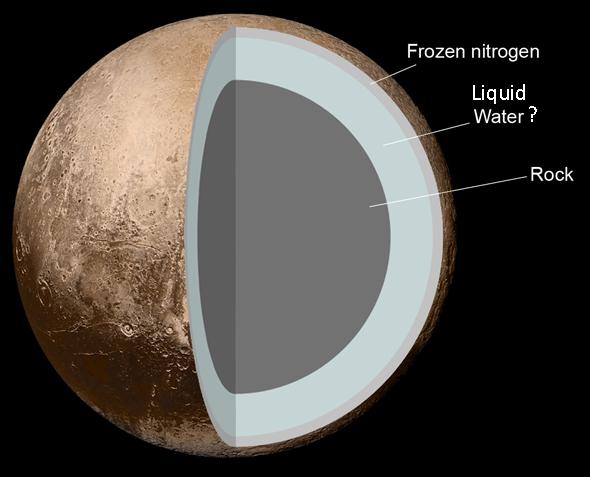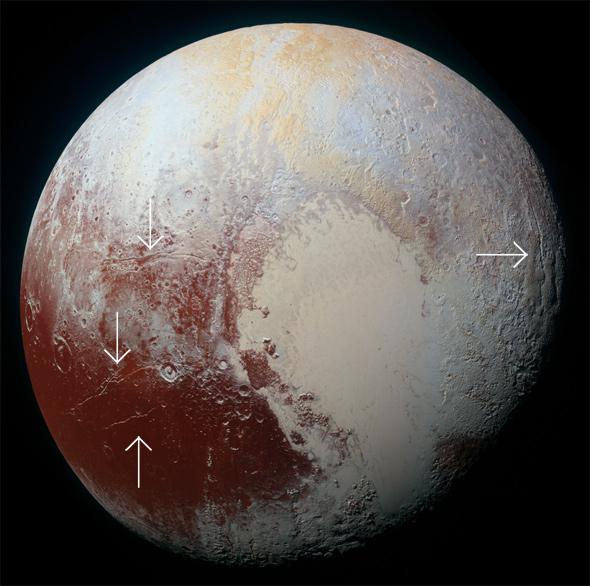Before the New Horizons space probe zipped past Pluto in July 2015, we weren’t sure what to expect. A lot was known about Pluto in general—given its density, it was likely a mixture of ice and rock, for example—but very little about was known about, say, the surface structure.
Then the little spacecraft flew by the little world, and our knowledge exploded. The close-up pictures were amazing, both beautiful to behold and tantalizing for the brain. There were lots of surprises, of course, including how diverse the surface was: There are frozen plains of nitrogen, mountains of water ice, dark and bright spots, huge fields of pits on the surface, and much more.
Scattered around the surface are another type of feature: huge cracks, some hundreds of kilometers long and many kilometers deep. They’re pretty interesting, and their presence has led one group of planetary scientists to make an astonishing claim: There may be a liquid water ocean under the surface of Pluto!
If this is true, it’s a very big deal. Pluto is small and extremely cold, so the last thing you’d expect is liquid water anywhere within 3 billion kilometers of it. How can this be?
First, the evidence. The cracks are called extensional tectonic features, meaning you get them when the surface extends, expands. Imagine covering a balloon with mud. Let the mud dry, then inflate the balloon a little bit. What happens? As the balloon expands, it pushes the mud from underneath. Mud isn’t stretchy like rubber, so instead of smoothly expanding it cracks, allowing the pressure underneath to be relieved.
That may be happening on Pluto. The solid crust (mostly water and nitrogen ice) is feeling pressure from underneath, expanding, and cracking. But what could be causing the expansion? Liquid water. And lots of it.
Pluto is mostly ice and rock. However, there is likely to be some amount of radioactive elements in its core. Our own Earth has them, and the heat generated by the decay of these elements is a major source of our planet’s internal heat, even 4.56 billion years after it formed.

Jcpag2012/NASA/Pat Rawlings/Phil Plait
Studies show that even a small amount of such material (including uranium, thorium, and potassium) could produce enough heat inside Pluto to melt some of the water ice. I’ll admit this surprised me; my gut reaction is that Pluto is so small that it would lose heat faster than the radioactive materials could generate it.
The new research just published looks into that. They show that the rocky material inside Pluto insulates it and keeps that heat from leaking away too quickly. The rock acts like a blanket, keeping the heat inside Pluto, and over time it could be enough to not only melt a substantial amount of ice, but keep it liquid even to today.
Well, mostly liquid. Pluto is pretty cold, and some of that water, especially closer to the surface, could start to freeze. When liquid water turns into ice, it expands, and it’s that expansion that’s proposed to cause the crust of Pluto to expand with it, creating the cracks.
How weird is that? Tiny, frigid Pluto, long thought to be a frozen ball of ice, may yet have some spring in its step.
And there’s more. The new research shows that if the ice shell covering Pluto is thick enough—deeper than about 260 km—then the water under the surface could form a strange kind of ice called ice II. It’s still made up of water molecules like regular ice, but under higher pressures (caused by the thicker shell) the molecules realign themselves, forming a different crystal structure than normal ice.
Ice II is denser than regular ice, denser even than liquid water. If it forms, the ocean under the surface would shrink, contracting to a smaller volume. If that happened, you’d expect to see compressional features on the surface of Pluto, like thrust faults.
However, none was found, so it’s unlikely ice II ever formed. That suggests the water under the surface is still liquid, even today. Incidentally, the cracks on Pluto are fresh-looking, with few craters marring them. This indicates relative youth, though it’s hard to know what that means on Pluto. Millions of years? Tens of millions?
Still, this is an intriguing idea. I expect there will be some back-and-forth on this, as the surface of Pluto is examined more closely. For example, there’s a mountain on Pluto that looks like it was pushed up, and then began to subside. If that’s the case, what does that tell us about the thickness of the crust there, and the forces underneath? Also, there are cracks on Pluto’s surface that aren’t linear so much as radial, as if whatever pressure under the surface were greater there than average. Maybe there’s material welling up there, pushing up on the surface.
And of course, there’s another thought. A source of heat, liquid water, and complex chemicals are three ingredients needed for life. Now have a care here: I am in no way saying there’s life under Pluto’s surface! My point is more subtle than that: We wonder if life exists out in the Universe, and the key to that is how commonly the necessary conditions arise. What we’re seeing on Pluto—and on Enceladus, and Europa, and Titan—is that these conditions at least in part appear to pop up quite a bit just in our solar system alone. Even in almost literally the last place you’d expect.
Oh Pluto, will you ever stop surprising us?
I certainly hope not.
